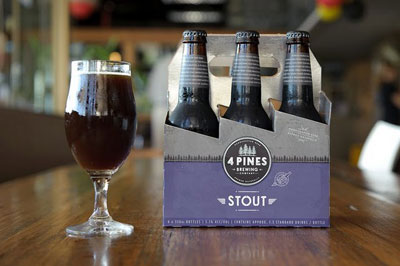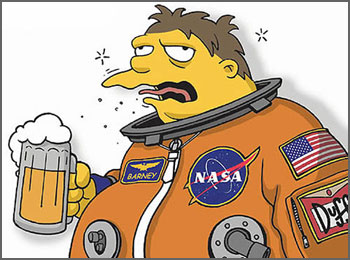Because in Space… It’s Always 5 O’Clock Somewhere
by
 Yesterday, April 12th, marked the 50th anniversary of the first manned space flight. During his 108-minute voyage, cosmonaut Yuri Gagarin completed an entire orbit of Earth in Russia’s first Vostok mission. And to commemorate that flight, a new space beer is currently being perfected and tested in various zero gravity environments.
Yesterday, April 12th, marked the 50th anniversary of the first manned space flight. During his 108-minute voyage, cosmonaut Yuri Gagarin completed an entire orbit of Earth in Russia’s first Vostok mission. And to commemorate that flight, a new space beer is currently being perfected and tested in various zero gravity environments.
Vostok “4-Pines Stout” is the first space beer to be developed, and is being done so in a collaborative effort between 4-Pines Brewery near Sydney and Saber Astronautics Australia. Here comes the (beer) science bit: According to the brewer’s website, Vostock is “a dry Irish style stout, presenting almost black, bearing a generous tan head. The aroma profile is of coffee, chocolate and caramel malts. These are matched on the pallet with a full-bodied, smooth finish and a balancing bitterness.” Sounds delicious to me!
An earth-friendly version of the stout is already widely available in Australia. However, making a beer suitable for consumption in space presents a variety of problems. The first is that the human tongue swells in zero gravity environments. This affects how our taste buds function. Secondly, the levels of carbonation needed in space are considerably lower than on our planet. Not to mention the bubbles don’t know which way is up, so forming a frothy head is tricky. Therefore to enjoy a tasty, cold, frothy pint whilst gazing down upon the globe, the beer itself needs to be carefully (and probably repeatedly) tested.
 The only way to simulate “microgravity” without taking flight is to drop something from a 65-foot tall tower, imaginatively called a drop tower, and the only such tower in the southern hemisphere is at the Queensland University of Technology in Brisbane. So researchers Martin Castillo and company have been testing how beer behaves in a microgravity environment. Naturally, “Australian students are quite keen to develop microgravity beer projects,” (Castillo). Unfortunately the drop-test experiments don’t involve any taste testing, but I doubt any leftovers go to waste.
The only way to simulate “microgravity” without taking flight is to drop something from a 65-foot tall tower, imaginatively called a drop tower, and the only such tower in the southern hemisphere is at the Queensland University of Technology in Brisbane. So researchers Martin Castillo and company have been testing how beer behaves in a microgravity environment. Naturally, “Australian students are quite keen to develop microgravity beer projects,” (Castillo). Unfortunately the drop-test experiments don’t involve any taste testing, but I doubt any leftovers go to waste.
Back in February Vostok Stout was taste tested by an astronaut experiencing zero gravity in a plane flying in parabolic arcs. In this commonly used way of simulating space-like conditions, a specially modified Boeing 727 plane flies in stereotypical parabolas, which results in any passengers avoiding the gravitational pull of earth for periods of about 30 seconds at a time. During the flight, the taste-tester drank almost a liter of beer, and reported no ill effects. Drinking a carbonated beverage in that kind of environment is kind of like being shaken with bubbles in your belly, so clearly it was a critical test that Vostok passed with flying colors.
Hmm… do you think you burp or fart after drinking beer in space?
 But why are these Aussies so interested in brewing the perfect space beer? Astronauts aren’t supposed to consume alcohol whilst on a mission, so it’s not like the International Space Station will be installing a bar. Well, starting in 2012, Richard Branson’s company Virgin Galactic will be offering trips into space for a bargain $200,000. Sounds like an expensive booze cruise, but I’m sure the price will come down eventually. What do you think is next? Space Veuve Clicquot?
But why are these Aussies so interested in brewing the perfect space beer? Astronauts aren’t supposed to consume alcohol whilst on a mission, so it’s not like the International Space Station will be installing a bar. Well, starting in 2012, Richard Branson’s company Virgin Galactic will be offering trips into space for a bargain $200,000. Sounds like an expensive booze cruise, but I’m sure the price will come down eventually. What do you think is next? Space Veuve Clicquot?
.
.
Katie Pratt is a graduate student in Molecular Biology at Brown University. She has a passion for science communication, and in an attempt to bring hardcore biology and medicine to everyone, she blogs jargon-free at www.katiephd.com. Follow her escapades in the lab and online on Twitter.
.
.
Be the first one to mind the gap by leaving the correct drop tower height (+/- 1 foot) as a comment and get your name in the blog along with a sweet new BenchFly mug!
.
UPDATE: Congratulations to Emily Bruggeman – winner of this edition of Mind the Gap!
About the Winner: Emily is a neuroscience Ph.D. student at Georgia State University.
.
About the prize: In addition to fame and glory beyond their wildest dreams, winners receive our new hot-off-the-presses large (15 oz) BenchFly mug to help quench their unending thirst for scientific knowledge… or coffee.

.
.
Miss a previous edition of Mind the Gap? We’ve got you covered:
Curry: Now Good for Detecting Explosions, Not Just Causing Them
So You Thought Eating Poop Was Bad For You?
Are Fatty Acids the Cure for PMS?
Botanical Sleuthing Recovered Endangered Daisy
.
.


Emily Bruggeman
wrote on April 13, 2011 at 2:07 pm
65 feet!
alan@benchfly
wrote on April 13, 2011 at 2:21 pm
We've got a winner! While there may be various drop tower heights used around the world, the one used by 4-Pines is 20 meters (65.6 ft).
Jessica M.
wrote on April 13, 2011 at 2:09 pm
479 ft
@aemonten
wrote on April 13, 2011 at 2:13 pm
75?
Tom Mc
wrote on April 13, 2011 at 2:17 pm
27 meteres
Tom McWilliams
wrote on April 13, 2011 at 2:18 pm
27 metres
CDP
wrote on April 13, 2011 at 2:21 pm
23 metres (75 feet)
Dirty Mouth? Clean It Up with Cancer Screening
wrote on April 27, 2011 at 4:16 pm
[…] Because in Space…It’s Always 5 O’Clock Somewhere […]
Biel_ze_Bubba
wrote on June 18, 2011 at 4:28 am
A liter of beer in 30 seconds? You'd need an Australian to do that experiment!
Oh, wait…